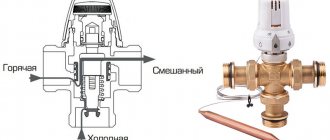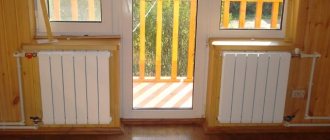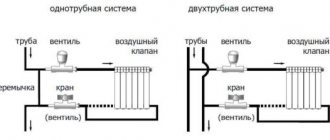A garage often performs several functions for its owner. In addition to its main purpose of storing the car from intruders and natural disasters, it also serves as a repair area and a warehouse for spare parts, fuel and lubricants, and often a resting place. If it's summer outside, there are no questions. Open the gate, turn on the carrier and repair as necessary. But if the temperature outside is very sub-zero, then you can forget about a comfortable pastime or work. And it’s worth thinking about how to build heating in a garage using antifreeze with your own hands, if no other decisions have been made.
Advantages and disadvantages of using antifreeze in a heating system
The main reason why antifreeze is poured into the garage heating system is that in this case there is no need to worry about the batteries defrosting during severe frosts. The crystallization threshold of antifreeze is much lower than that of ordinary water. Depending on the brand, it does not freeze at -20, -30 and even -40 degrees. Antifreeze, of course, may thicken somewhat, but this will have absolutely no effect on its qualities and when heated it will quickly turn into a liquid state again. At the same time, its boiling point is higher than that of water, so in this respect it is safer.
However, there are many more disadvantages, or more precisely, some inconveniences, of using antifreeze in a garage heating system installed with your own hands. It’s worth mentioning right away that these inconveniences relate rather to the process of assembling the system, during which it is necessary to observe certain safety measures and take into account the properties of this non-freezing liquid. All of them are worth listing and explaining a little:
- Viscosity. This property of antifreeze, which is much higher than that of water, requires the installation of a more powerful circular pump.
- The heat capacity, on the contrary, is much lower. That is, when the water heats up to 30 degrees, the antifreeze under the same initial conditions will only reach 20-25 degrees. And this can only be compensated for by installing additional radiators.
- Fluidity. This component is also high-grade, which means you will have to carefully check the system for cracks in order to avoid the slightest leak.
- With a long absence of circulation, in other words, stagnation of liquid, flakes can form, which, settling, can render the entire heating system unusable.
- Lifetime. Antifreeze will serve as a garage heating liquid for no more than five years. After this, you will have to drain it, thoroughly rinse the entire system and fill in a new one.
- And the main disadvantage of antifreeze is that it is poisonous. And not only the liquid itself, but also its vapor. And under the above-mentioned condition of increased fluidity, the possibility of it leaking and entering the atmosphere of the garage is very possible. If this problem is detected, you should immediately eliminate the cause of the leak, thoroughly rinse and ventilate the room.
There are many more disadvantages. However, this does not mean at all that you should forget about a garage heating system using antifreeze, installed by yourself. It’s just that all work on the installation of heat exchangers, heating radiators and pipes needs to be carried out more carefully and in compliance with all safety regulations.
Water or oil?
There are certain nuances associated with filling with water.
Mistake #8
For the home, it is water that is recommended, and not some kind of chemical antifreeze (ethylene glycol, antifreeze, antifreeze).
As it works and heats up, the liquid will evaporate in any case and find its way out through the upper valves. You don't want to breathe such chemicals in your home.
But for a garage, shed or cottage with good ventilation, whether you like it or not, you will have to pour anti-freeze. Choose the most environmentally friendly one (sweet winter, warm house, etc.).
Otherwise, a battery with water that is disconnected for a long time will simply defrost.
Those who have the opportunity add oil. Not a spindle or working off, but a transformer one. With it, the battery will never freeze. This oil is also an excellent insulator. There will be no need to be afraid of current leaks when the heating element shell is destroyed. Just keep in mind that with such “refueling” you will have to look for a special oil heating element.
Mistake #9
An ordinary water one will overheat and quickly fail due to thick oil and poor convection.
For fire safety purposes, heating in direct contact with oil should not exceed 250 degrees. In addition, the oil will quickly corrode all the rubber gaskets between the sections.
Heating in a garage using antifreeze - installation details
Installation of the entire heating system begins from the stove.
- Based on our preferences and capabilities, we install a heating device in the selected location. Electric or gas boiler. A stove that runs on wood, exhaust or another type of fuel.
- We hang aluminum or cast iron radiators in such a way that the heating of the entire room is uniform.
- Pipes for connecting radiators to the stove should be selected taking into account the viscosity of the antifreeze. That is, their diameter must be at least 1.5 times larger than for water heating.
- The circular pump is installed in the system at a distance of at least 1 meter from the heating device. It is recommended to install shut-off valves on both sides. This is done so that it is possible, if necessary, to remove the pump, without having to drain the antifreeze from the entire system. The pump itself should be selected so that it is twice as powerful as when used in a similar heating system operating on water.
- We install the expansion tank as high as possible. The ideal option would be to take it to the roof
- Carefully connect all elements. It is better not to use threaded connections. This is due to the increased fluidity of antifreeze, which easily seeps through such connections. But a high-quality welding seam will easily hold it.
- Filling the antifreeze system is carried out as follows:
- Approximately 2/3 of the required volume is poured into the expansion tank.
- The circulation pump turns on.
- You should drive the system a little, carefully monitoring the antifreeze level.
- Add if necessary.
- After making sure that everything is working properly, there are no leaks and the antifreeze level is appropriate, you should carefully seal the expansion tank.
- Now you can start the stove for the first time.
- During the first month or two, it is recommended to conduct a daily visual inspection of the entire system, especially the joints and connections for leaks and other faults.
When installing a heating system in a garage using antifreeze, special attention should be paid to ensuring that all elements are made of materials that are neutral to the substances contained in this non-freezing liquid. Aluminum meets these requirements, but it is quite expensive and much more difficult to install. You can use thick-walled iron pipes, especially if your system includes a homemade stove.
How to find the perfect formula
When the battery is too long (12 sections), it is better to screw in two instead of one 1.5 kW heating element. At the bottom of the radiator, on one side there is 1 kW, and on the other another 0.5 kW.
Or two, 0.7 kW each. Thus, the heating of the sections will be more uniform.
Mistake #7
Just don't forget to check the threads on the heating elements.
It is different on both sides of the battery. When purchasing a heating element, pay attention to the letter, which indicates a right-handed or left-handed thread (1.1/4R or 1.1/4L).
According to factory parameters, such batteries (with a height or center distance of 500 mm), when integrated into a full-fledged hydraulic heating system, are capable of dissipating slightly less than 200 W of thermal power per section (180 W aluminum, 140 W cast iron).
However, in our case, do not expect such numbers. Firstly, the heat output of 180/140W is provided only by a new battery. And for such a heater, as a rule, used options are used.
Buying a new one for such a homemade product is not economically feasible.
Secondly, such work is only possible in the 90C-supply, 70C-return mode. In this assembly we use heating elements with an optimal operating temperature of 60-65C.
When it’s cold outside down to -25C, you can turn it up to +70-75C. The maximum possible temperature is + 80C.
Therefore, you will never heat such a battery to 90C in NORMAL operation. In principle, this is not necessary, since it entails the risk of a sharp increase in pressure.
When screwing in the heating element, rarely does any of it reach the last section. Usually their length varies between 35-40cm.
There are also exclusive models for all sections, but made to order (for example, Grepan). Here are comparative tables of uniform heating of the same battery (10 sections) with a standard short heating element and an extended one from Grepan.
However, most of us still use short ones. How then can we ensure uniform heating over the entire area?
Other garage heating options
For regions with frosty and long winters, antifreeze in the garage heating system is the most acceptable option. However, there are other ways.
- Water heating. The system is identical to the one described above. Only instead of antifreeze, water is poured into it. Heats up faster. Among multi-level homemade products, one of the simplest. But in case of untimely start-up, it can lead to defrosting of the pipes and complete failure.
- Air heating. Probably the only system that does not have significant drawbacks. Installation is no more difficult. Can be left indefinitely without needing to reheat.
- Electric heating. Using air heaters, air guns and other devices. Practically safe, but very expensive.
- On liquefied gas. A gas heating boiler is required, to which a propane cylinder is connected. Quite an economical option, but there is a risk of fire. It is not recommended to leave a running installation unattended.
- "Potbelly stove." A small iron stove that consumes all types of solid fuel. Fast heating, good heat dissipation. The disadvantages include the mandatory construction of a chimney and increased fire hazard.
Whatever type of heating system you install in your garage, the main thing is to understand that safety should always come first. Choose a place for the stove away from reserves of fuels and lubricants.
For car enthusiasts, a garage is a personal space for doing what you love. The space is arranged to suit your own needs, be it a workshop or even a place to relax. That’s why it’s so important to come up with high-quality garage heating. We will try to find the most economical way in this review. With the right approach, the heating system in the garage will be economical and safe.
High-quality heating allows you to create comfortable conditions in any garage
Rules of operation and maintenance
In order for the heating element installed in the heating battery to serve as long as possible, the following rules are observed:
- The heater turns on only if there is water in the battery. If liquid gets on the already heated tube of the device, a small thermal explosion may occur. As a result, not only the heating element will fail: the heating battery may be damaged.
- During operation of the device, scale will form on its surface, which must be cleaned off periodically. The recommended maintenance schedule is once every three months. If the thickness of scale on the heating tube exceeds 2 millimeters, heat transfer will decrease and the device may fail.
- To eliminate possible voltage surges, it is recommended to connect the heating element through an uninterruptible power supply or stabilizer. When installed, the heater is grounded.
- Manufacturers recommend using only distilled water as a coolant. In apartment buildings with a common riser, it is unrealistic to comply with this requirement, so it is necessary to clean the heating elements from scale more often.
Heating a garage: the most economical way, what to choose
If the outbuilding is located next to the main building, gas heating is often used. In this case, the heating system can be connected to an existing one in the house.
To heat your garage yourself economically, you can use the heating option using different types of solid fuel raw materials. Which can be used as firewood, peat, coal and diesel products. At the same time, you can save on resources, but it is important to think about the storage of raw materials.
A simple potbelly stove can adequately heat a small room
For your information! A simple solution is a gas convector. In such equipment, heat circulation occurs due to convection. The device is connected to a cylinder, but it will need to be refilled every few days.
Filling the radiator with water
How much liquid is needed for such a heater?
Mistake #10
When filling a radiator, you don’t want it to end up 100% full of water.
Filling occurs through the hole of the already installed passage plug. First, fill the radiator up to the neck.
Then you set it perfectly level and unscrew the plug or the Mayevsky valve (not the fitting itself), draining the excess volume.
If the battery is already hanging on the wall, you can use a small watering can with a tube or hose stretched over the spout.
Mistake #11
Try not to use regular tap water. The water should be soft. A hard one will kill your heater very quickly. Distilled or rainwater is best (it's free). As a last resort, water from an osmosis filter. Just enough water is needed so that it stops flowing through the hole under the Mayevsky tap. That is, the liquid level should end exactly at the level of the small hole in the passage fitting.
When pouring water along the edge of the hole, you will automatically get the desired level of the liquid column, which will ensure uniform, proper circulation.
One section of a cast iron battery (MS 140-500) holds about 1.5 liters of water. In aluminum (height 500mm) - no more than 0.35-0.45 liters. The required volume is calculated by the number of ribs.
What heating methods are there for a garage?
The most economical way to heat a garage is determined by many factors: availability of fuel raw materials, financial capabilities and distance from the main home.
Heating of the engine shelter can be carried out by the following devices:
- mobile equipment: heat guns and fans for heating;
Related article:
Diesel fuel heat gun. The advantage of such equipment is mobility. After all, you can simply move them wherever you need. Read the article on how to choose this device correctly and what you should pay attention to.
- infrared heaters;
Such a device does not release harmful combustion products into the air
- electric boiler is suitable for spacious rooms; stationary heaters.
High-quality heating equipment is important to create a favorable environment in the garage.
Advantages of electric heating in a garage
It is recommended to consider heating your garage with electricity as the most economical option. It has the following advantages:
- ease of installation and availability of electricity;
- a wide selection of devices of various types;
- you can choose a device with suitable power;
- rapid heat transfer.
Convectors are used as heating devices
The disadvantages of such equipment include its high cost. Keep in mind that the quality of heating depends on the uninterrupted operation of the electrical network.
You can use these methods:
- heat guns are an inexpensive option; after heating, air masses in them are distributed under the influence of a fan;
- infrared equipment heats surfaces and all kinds of objects, and they provide heat. Infrared rays will not harm the car's paint;
- the convector warms itself up and distributes the heat around. It heats the space worse than a cannon, but the heat lasts for a long time;
- The most expensive options include inverter split systems. They allow you to save electricity.
Electric heat gun models heat compact rooms quickly enough
Helpful information! Thermal models are recommended for small spaces. Fan heaters and heat guns not only warm up, but also help dry the wheels and bottom of the car.
Water heating
If the garage is built close to the main building, then the most economical option is to heat the garage in connection with the main heating system.
In this case, you do not need to install a boiler, but you will need to extend the pipeline. This option will lead to loads and an increase in the amount of fuel. If a separate boiler is used, then full power can be used if necessary, and in other cases the equipment operates at rated level.
Water heating can be done not only from a boiler, but also from a stove
Note! To avoid defrosting, you should use antifreeze instead of water in the system.
Gas heating
The most effective option is gas. This is a good solution in cases where there is a gas main nearby. To install such a heat source, it is necessary to draw up design documentation and obtain a special permit. Using gas requires compliance with all safety measures. It is prohibited to use a homemade device or connect any equipment.
Operating principle of heating elements
The heating element works according to the following principle. When connected to the network, the internal spiral is heated and energy is transferred to the thermal conductor and the outer shell. The heat is then transferred to the surrounding fluid, air or solid material.
When heating a heating element immersed in oil or water, convection currents are created around the tube, which mix the coolant and contribute to its uniform heating.
Electric boilers are known for their reliability and maintainability. They do not have many complex parts, so they are easy to operate and maintain.
In liquid-free heating devices, the heating temperature is usually limited so as not to damage surrounding parts or cause a fire.
To speed up heat transfer, they often use a fan, which circulates air both inside the device and in the room surrounding it.
Review of popular models of garage stoves
There are a variety of options for garage stoves on the markets. They differ in the heating principle and design solutions. Some models deserve special attention:
- The Bullerian stove is made to run on solid fuel. The design has a convection mechanism for high-quality heating of air masses that move through the pipes;
- a durable option is the Stavr stove. It is made of cast iron, a similar material can withstand high temperatures;
- Termafor stoves have convection pipes in their design, which are placed in the combustion chamber. Such models are designed for both standard and pyrolysis combustion;
- The Alaska stove has a stylish design and good heat output. The design is equipped with a hob;
- A cheap alternative to Buleryan is the model of the domestic manufacturer Breneran. It can operate on wood and waste from the manufacturer.
| Image | Model | Construction type | Price, rub |
| "Delta" D-81G | Heat gun | 3930 | |
| Ballu BHDN-80 | Diesel indirect heating device | 55900 | |
| ELITECH TP 3G | Ceramic gas panel | 2960 | |
| Resanta | Gas heat gun | 6700 | |
| Breneran AOT – 06/00 | Wood stove | 10500 |
Some stove models are assembled independently
Application
In what cases does it become advisable to operate a heating system based on electric heating elements? These elements can be used to organize autonomous, local heaters, additional heating of the coolant, or in the structure of a centralized heating system.
This solution seems especially relevant if it is necessary to create an “emergency” heating system for housing. In case of extremely unstable heating operation, the heaters maintain a comfortable level of heat and protect the radiators from freezing.
The use of functional thermostats along with heaters allows you to accurately adjust the temperature of the coolant. The presence of special temperature sensors protects the device from overheating.
In addition to the main ways to use shadows, there are a number of additional functions:
- “Turbo” mode - with appropriate control of the thermostat, the heating element produces maximum power for some time. This makes it possible to quickly and efficiently heat the room until the required temperature is reached.
- Anti-freeze function - maintains a minimum temperature, preventing the coolant from freezing in the heating radiator.
How to make garage heating with your own hands cheaply and quickly: choosing the right place
The location for installing the equipment is selected taking into account fire safety. Heating appliances powered by gas can be used in rooms with excellent ventilation. In addition, it is important to consider the chimney device. The selected device should be attached to the main wall. It is important to correctly calculate the performance of the hood. It is important to provide free access to heating equipment.
Fireplace stoves provide not only high-quality heating, but also an aesthetic appearance
Note! When using hearths with an open fire, do not close the vent until the fuel has completely burned out. You must remember to turn off heating devices for the garage at night.
Using an economical heating method will allow you to fully use the garage at any time of the year.
Product types
Electric heating elements differ in:
- type of work environment. There are models for heating gas (air) and liquid;
- type of working surface. They can be tape, rod, ribbed, tubular;
- method of use. There are products designed for installation in radiators, boilers, boilers and other equipment;
- technical specifications. The power per unit surface is taken into account;
- functionality. There are models with a thermostat and automatic shutdown sensors when overheating.
Structure
Let's take a more specific look at what an electric heater is for a radiator. In essence, this heating element is nothing more than a metal tube into which a copper spiral is mounted. Using a special filler, the spiral is insulated from the tube.
This simple design is built into a protective housing, which ensures the safety and reliability of the heating element.











